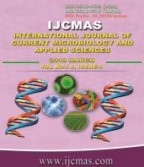


 National Academy of Agricultural Sciences (NAAS)
National Academy of Agricultural Sciences (NAAS)

|
PRINT ISSN : 2319-7692
Online ISSN : 2319-7706 Issues : 12 per year Publisher : Excellent Publishers Email : editorijcmas@gmail.com / submit@ijcmas.com Editor-in-chief: Dr.M.Prakash Index Copernicus ICV 2018: 95.39 NAAS RATING 2020: 5.38 |
Soil loss was estimated from agricultural lands of South Andaman district in tropical Bay Islands applying Universal Soil Loss Equation (USLE). Mean annual rate of soil loss to the tune of 184.1 X 103 tons was estimated from the crop fields of the district covering 1747.0 ha area at the rate of 105.38 t ha-1 yr-1. In South Andaman district, kharif crops (rice, maize, arhar, ground nut, ginger, sweet potato, tapioca and turmeric) are grown in medium to low lands whereas rabi crops (pulses and vegetables) are grown in uplands. The cropping intensity is 104.0%. Maximum (136.8 thousand tons) and minimum (0.06 thousand tons) soil loss was obtained from the cultivation of vegetables (1317.0 ha) and arhar (0.5 ha), respectively. The highest (124.8 t ha-1 yr-1) and the lowest (70.6 t ha-1 yr-1) rate of soil loss were obtained from the cropping pattern of rice-fallow-fallow and ginger-fallow, respectively. Among the double cropped land, the sequence of sweet potato-vegetable-fallow contributes the lowest rate of soil loss (68.76 t ha-1 yr-1), whereas the cropping sequence of rice-fallow-vegetable yielded the highest rate of soil loss (106.25 t ha-1 yr-1). The average rate of soil loss from double cropped land is 86.02 t ha-1 yr-1. The study reveals that converting more mono crop area into double cropped land will reduce the average soil loss annually by 18.4%.
 |
 |
 |
 |
 |